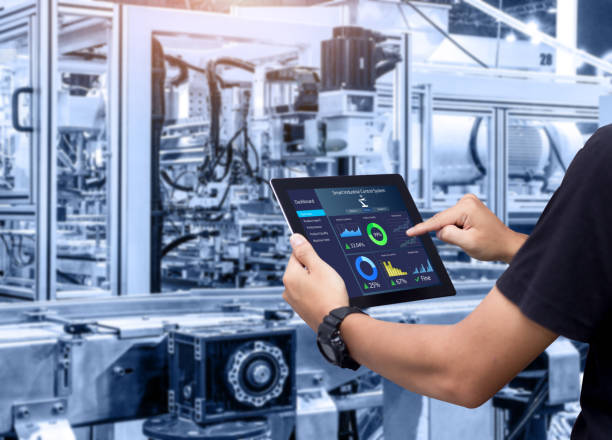In today’s rapidly evolving world, the increasing role of technology in manufacturing is transforming the industry landscape. As a critical player in this sector, you are witnessing the shift from traditional methods to a more connected and automated approach. Understanding and embracing these advancements is crucial for adapting to the changing demands of the global market and remaining competitive.
Implementing modern technology in your manufacturing processes can lead to higher efficiency and improved product quality and even open up opportunities for upskilling and cross-functional collaboration among your employees. The technology significantly enhances the manufacturing ecosystem, from automation reducing human error to integrating digital solutions. As you navigate the world of Industry 4.0, it’s essential to identify suitable applications to boost productivity, streamline processes, and find new ways to attract and retain top talent.
Moreover, as manufacturing increasingly relies on services and contributes more to innovation, productivity, and trade, you must continuously evaluate your digital strategy. As you embark on this journey, stay informed of the latest trends and best practices to maximize the potential of your manufacturing operations and unlock the benefits of embracing technology.
Kenny Riley with Velocity IT in Dallas and Nick Martin with Mainstreet IT Solutions share insights into technology and manufacturing.
Page Contents
The Evolution of Technology in Manufacturing
Historical Progression
The journey of technology in manufacturing can be traced back to the early days of the industrial revolution. At that time, using steam engines and mechanized looms marked the beginning of a new era, enabling mass production and increased efficiency. As you progress in history, the development and integration of electricity, assembly lines, and computer-controlled machines have played an essential role in shaping the current manufacturing landscape. These advancements have influenced how products are produced and streamlined processes, benefiting manufacturers and consumers alike.
Industrial Revolutions
The First Industrial Revolution (1760–1840): The first significant shift in manufacturing involved the transition from manual labor to mechanized systems. During this period, you see how innovations like the spinning jenny and the steam engine transformed the textile and transportation industries, respectively.
The Second Industrial Revolution (1870–1920): This period introduced significant advancements in steel production, electricity, and communication systems, laying the groundwork for modern manufacturing. Developments such as the telephone and the light bulb marked a significant turning point for factories, expanding their capabilities and enabling more efficient production.
The Third Industrial Revolution (1960–present): The third phase of the industrial revolution, often called the digital revolution, is characterized by the widespread integration of electronics and computer systems in manufacturing processes. Automation, robotics, and computer-aided design (CAD) significantly changed how products are conceived, designed, and produced. This period has led to unprecedented production efficiency, product quality, and flexibility improvements.
The Fourth Industrial Revolution (ongoing): Defined by the ongoing convergence of digital, physical, and biological technologies, Industry 4.0 has transformed manufacturing by leveraging data and analytics, artificial intelligence (AI), and machine learning (ML). This has allowed manufacturers to optimize production processes, reduce waste, and increase efficiency. The adoption of Industry 4.0 technologies continues to grow and evolve, promising even more significant advancements in the manufacturing sector.
Modern Manufacturing Technologies
This section will explore some of the most significant modern manufacturing technologies shaping the industry’s future.
Automation and Robotics
You will find that Automation and Robotics have become increasingly important in manufacturing processes. They enable higher efficiency and precision, reducing labor costs and improving product quality. Some key advantages include:
- Increased productivity
- Consistent output quality
- Reduced human error
- 24/7 operation capability
Artificial Intelligence and Machine Learning
AI and Machine Learning are revolutionizing manufacturing by allowing for predictive analytics, process optimization, and improved decision-making. These technologies enable:
- Enhanced forecasting based on data analysis
- Improved quality control and defect detection
- Real-time adjustments for optimal performance
- More efficient resource allocation
Computerized Maintenance Management Systems (CMMS)
Implementing a CMMS helps you streamline the maintenance of your manufacturing assets and equipment. Some benefits of adopting CMMS include the following:
- Reduction in unplanned downtime
- Better inventory management for spare parts
- Improved safety through structured maintenance protocols
- Easier compliance with industry regulations.
Digital Twins
A digital twin is a virtual representation of a physical asset, process, or system. By leveraging this technology, you can:
- Simulate and optimize production processes
- Improve design accuracy and reduce time to market
- Monitor and predict equipment performance
- Make data-driven decisions to enhance productivity
Additive Manufacturing
Commonly known as 3D printing, additive manufacturing allows you to create complex parts and prototypes with increased design flexibility. This technology enables:
- Faster product development cycles
- Customization and personalization of products
- Reduction in material waste during production
- Lower costs for small batches or one-off production
Automated Integration
Automated integration connects and synchronizes various manufacturing systems, from production lines to supply chain management. By investing in automated integration, you can:
- Improve data sharing and communication between systems
- Optimize resource allocation and scheduling
- Increase visibility on production bottlenecks and inefficiencies
- Enhance overall operational efficiency
Impact on Labor and the Workforce
Job Transformation
As technology increasingly integrates into manufacturing processes, your workforce will experience significant job transformation. Advanced robotics, artificial intelligence (AI), and automation revolutionize manufacturers’ operations. These advancements are creating new job opportunities and transforming existing positions. This means your workforce must adapt and acquire new skills to stay relevant.
Reskilling and Upskilling
A critical aspect of adapting to technology-driven changes in the manufacturing sector is investing in reskilling and upskilling your employees. This ensures your workforce remains competent by acquiring relevant knowledge and skills to work with emerging technologies like AI and robotics. By reskilling, your employees will learn new skill sets to operate in a different job function. On the other hand, upskilling enhances the existing skill set, allowing them to work more efficiently with new technology in their current role.
To implement effective reskilling and upskilling programs, consider the following steps:
- Identify the areas of your manufacturing process most influenced by technology and require updated skills.
- Develop targeted training initiatives on the skills needed to excel in your evolving manufacturing environment.
- Encourage a learning culture within your organization and provide resources, such as access to online courses or on-the-job training, to enable continuous learning and development.
- Measure the progress and outcomes of your reskilling and upskilling programs to gauge their effectiveness and make necessary adjustments.
By embracing these strategies, you can help ensure your workforce remains competitive in a rapidly changing industry and effectively manage the impact of technology on labor and the workforce in your manufacturing business.
Environmental and Sustainability Considerations
Energy Efficiency
As a manufacturer, adopting energy-efficient practices in your production processes is crucial. By doing so, you not only decrease your ecological footprint but also enhance your profitability. You can switch to alternative energy sources and invest in energy-efficient systems within your facility. Moreover, utilizing low- or zero-carbon raw materials and adopting greener product designs contribute to a sustainable operation, keeping in mind the circular economy.
Waste Reduction
Reducing waste throughout your manufacturing processes is another vital element of sustainable operations. Leveraging new manufacturing and materials technologies can decrease emissions and waste during production. Your waste management efforts should encompass both waste prevention and recycling. Implementing advanced and efficient processing technologies can allow you to achieve a significantly lower emission rate, benefiting both the environment and your company’s image.
Remember to continually monitor and improve these environmental and sustainability considerations as technological advancements continue to provide opportunities for environmentally responsible manufacturing.
Challenges and Future Prospects
As you venture into the increasing role of technology in manufacturing, understanding the challenges and prospects is crucial to anticipate the direction of the industry. We will discuss three key aspects: Industry Adoption, Data Security, and Privacy.
Industry Adoption
You need to be aware of the challenges of adopting new technologies in the manufacturing sector. As seen in various sources, manufacturing businesses have faced labor shortages, requiring them to incorporate more automation processes. However, some smaller manufacturing companies may struggle to adapt to this shift due to the high costs of implementing new technology. It would be best to consider employees’ potential reluctance due to concerns about job displacement and the need for reskilling and upskilling workers.
Data Security
Another challenge you should consider is data security. With increased reliance on Industry 4.0 technologies like the Internet of Things (IoT), massive amounts of data will be generated, processed, and analyzed. This raises concerns about protecting sensitive information and safeguarding against potential cyber-attacks or data breaches. You must understand the importance of implementing robust security measures and incorporating best practices to address these risks.
Privacy
Lastly, as you explore the role of technology in manufacturing, keep in mind the importance of privacy. Integrating data-driven technologies may lead to collecting and analyzing new types of personal data, which raises questions about ensuring individual privacy. Adequate measures should be taken to balance these technologies’ benefits and protect privacy rights. This includes implementing policies and procedures that respect data privacy while fostering innovation and growth in the manufacturing sector.



